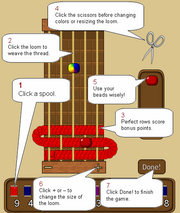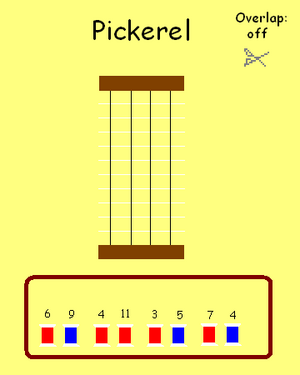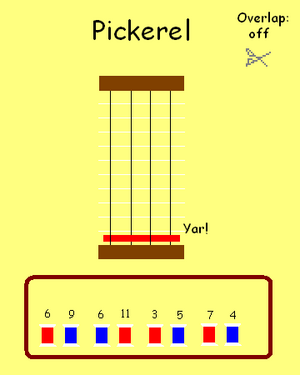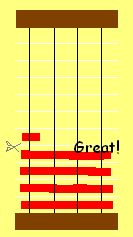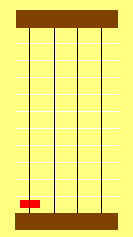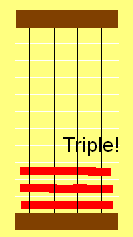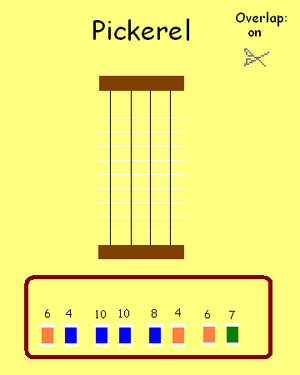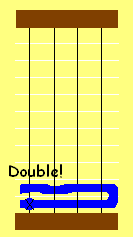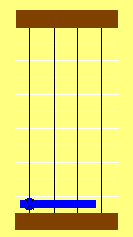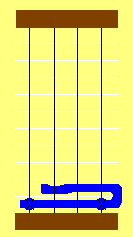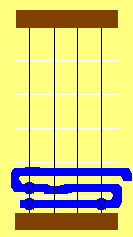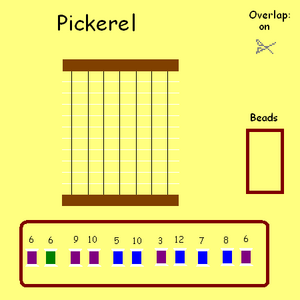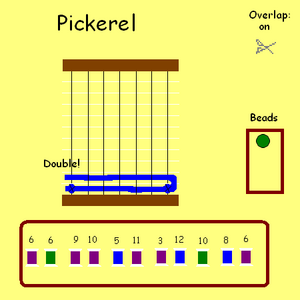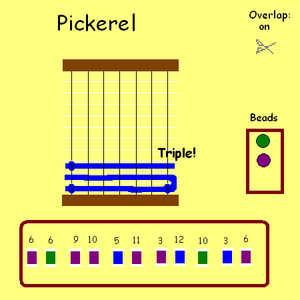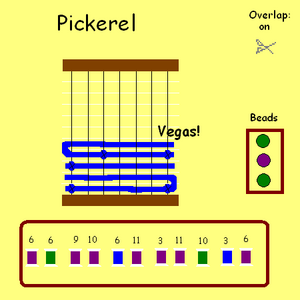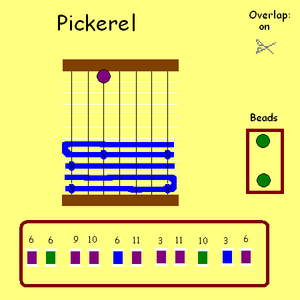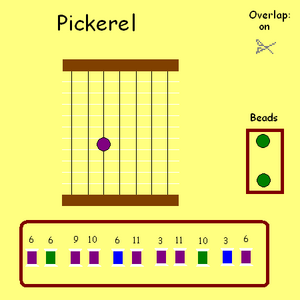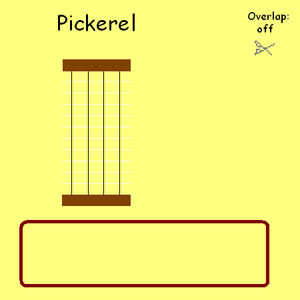GCPP:Proposal-Pickerel
Puzzle Codename: Pickerel
| Contact | |
| Username: | Tcarr |
| Additional contact info: | on Midnight as Lordkalvan, otherwhen@frontiernet.net |
| Project forum thread: | Forum Thread |
| A game gardens puzzle is available for this proposal. | |
| Play it and help as a tester! |
Game concept
Build lengths of cloth from available threads, wasting as little as possible, under no time pressure. [ Play it now on GameGardens!
Pickerel Basics
Complete as many rows as possible. Each row must be a single color. Consecutive perfect rows in the same color and completing squares earn bonuses.
To play, click a spool then click the loom to weave the thread from that spool. One unit of thread is used to make a knot, and a unit is used each time you wrap from one row to the next.
To drop a spool you don't want after all, simply click any empty place on the board. That is, click somewhere that isn't a spool, bead, scissors, or the loom.
Clearing the Loom
When a square is formed, all completed rows are scored and removed. If the color changes or the loom is resized, then any thread on the loom is wasted. To minimize waste, click the Scissors before changing colors or resizing the loom.
Resizing the Loom
One key to high scores is consecutive perfect rows. If you see a + at the bottom of the loom, you can click it to make the loom wider. Similarly, clicking a - will make the loom narrower.
Finishing
The game finishes when the last spool is used. Any completed rows on the loom are scored, and leftover thread is penalized. If there aren't enough spools left in the tray to finish another row (or if you just want to stop) click the Done button.
Beads
Consecutive perfect rows will sometimes award you with a bead. The 'Any' bead can be used to splice any two spools of the same color. The 'Wild' bead can be used to splice two spools of different colors, dying the first length of thread to match the color of the second spool. Beads can also be placed on the loom for a possible later bead bonus.
Splicing
If you have a bead of the appropriate type/color in the bead tray, you can click a spool and the bead (in either order), then click a second spool in the spool tray. This replaces the second spool with a new spool of the same color but with a length equal to the sum of the spools. The first spool vanishes, as does the bead used.
Placing a Bead on the Loom
You can click a bead in the bead tray and then click the loom. This places the bead on the loom, somewhere several rows above any threads. You may have as many beads on the loom as you like, however if the bead you are adding lands on top of another bead, the other bead is lost. Try to weave the correct color right up to "kiss" the bead for a nice bead bonus.
Difficulty Levels
Level 9 needs to be dropped if Pickerel is selected for YPP. It is included at the moment to make thorough testing of beads and various bead strategies easier. The other levels are fairly well balanced; an expert player can score 900+ points on any of the levels but can score much higher on the higher levels with a good strategy and a bit of luck. Skilled level players will score more than 500 points without trying very hard, on the low to medium levels.
Game Design Philosophy
Pickerel attempts to provide enjoyment at three different levels of play. Beginners can ignore perfect rows and beads and just start each new square with whatever color is most plentiful in the spool tray, adding the spools of that color to the loom until a square is formed, then changing colors. This is roughly the same level as telling beginning bilgers to just look from the top down and take the first three in a row they can find, and should be good for Able labor.
Players who think about the size of the loom and can spot the spools that will give perfect rows should be able to provide Skilled labor without thinking too hard about it. The beads at this level of play are most useful for splicing to make more possible perfect rows. At this level, the play is still very relaxing, with enough score animations to avoid boredom for the five minutes or so it takes to play. This is roughly the same level as telling bilgers to find the biggest one or two move combo on a board.
Players who want to actively work at getting the best score possible are challenged by constant decisions. Do I use this bead to splice, or put it on the loom? Should I switch colors now, or try to finish this square for the square bonus? What loom size is best for this set of spools? Players who enjoy mathematics will find these types of decisions enjoyable. This is roughly the same level as bilgers who try to keep the pump golden if not gushing.
Inspiration for Game Design
The designer felt that YPP did not have enough puzzles that appealed directly to those who enjoyed math and logic puzzles. The basic idea for Pickerel came from the 0-1 Knapsack problem and the Bin-Packing problem.
Objective
Complete as many rows as possible. Each row must be a single color. Consecutive perfect rows, and completing squares earn bonuses.
Gameplay
When game starts, threads of various lengths in the different colors for this game are generated. The number of colors is determined by the difficulty level, but most levels will use 3 colors. Each color has a fixed total of "inches" of thread, determined by the difficulty level. The player can only see a fixed number of the spools of threads (determined by loom size); when one is used, another replaces it. Spools can not be discarded or recycled. The number of spools shown is (loom size + 4), so on the first three difficulty levels that will be 8.
The size of the loom (width of rows) is also determined by the difficulty. The easiest level will have a width of 4. Hardest level will have a width of 8.
The easiest level has no overlapping or knotting of threads, but all other levels require using one inch of thread to knot a new thread to either a woof or the previous thread, and to wrap from one row to the next.
Choose a color to weave, and place any thread from your tray in that color onto the bottom of the loom. The first thread will start on the left edge of the bottom row, and use one inch for a knot to start. Add threads until the row is finished. Attempt to choose threads that will exactly fill the row. For example, if the loom is 8 inches wide, and you first place a thread that is 6 inches long, you will want to look for a thread 4 inches long (one inch of overlap for the knot).
If more than one inch is dangling off the side, the thread wraps to the next row. There is no penalty for wrapping, but one inch is used (showing as another knot). If you want to change colors, the incomplete row is wasted, with a loss of one point per inch.
When a square is completed or you place a different color in the next row, the completed rows drop off the board and the score is calculated with a score animation.
Storyboard
Storyboard: Difficulty Level 1
Note: On difficulty level 1, the loom width is 4, there is no overlap (knots), 8 spools in the tray, two colors of spools, and a total of 200 inches of thread. Scoring is 4 points for a single perfect row, 8 for a double, 12 for a triple, etc. Rectangle bonus is 4 * number of rows. Square bonus is 16 points. There are no beads.
Cantra is playing her first game of Pickerel, so she gets a board with difficulty 1. There are eight spools near the bottom of the screen, in two different colors. Each spool is marked with the length of thread on that spool. Cantra sees 4 vertical woof threads on the loom. She decides to try the red spool marked 4, so she clicks it, and an animation weaves the a red thread across the bottom of the loom. The red spool has vanished, replaced by a different spool, and a score animation appears praising her for making a "Perfect row!"
Cantra now has to decide whether to continue with the same color to try to make a square bonus, or switch colors (there is a blue spool marked 4 in the tray). She decides to make a square, but there is no red spool with a multiple of 4. Randomly she clicks the red 6. This weaves a second full row, and wraps 2 inches on the third row. The only red spools left are 11, 3, and 7, but she needs 6 inches. She could use the 3 and hope for another 3 to appear, but instead she clicks the red 7. She gets a square bonus, and the four finished rows disappear from the loom. One inch of red is showing at the bottom of the loom, leftover from the 7.
Cantra looks at the tray again. Just two red spools: 11 and 3. But she has one inch on the loom, so she can get a perfect row if she uses the 11. She decides to not waste the inch, and hope for another red spool so she can finish a second red square. Since adding the red 11 spool makes a perfect row, the other rows it completes also count as perfect, so Cantra gets a triple! Three rows are complete, but the only red spool left is a 3. Should she risk wasting the three inches, hoping for another red spool? This time she plays it safe and switches color to blue. She gets a small bonus for the rectangle that is only three rows.
Cantra weaves with blue for a while, since the tray was mostly blue. After finishing one blue square, and using a blue 8 (Double!) she uses a blue 4 and gets another Triple!
Eventually she finishes a blue square and has no blue left in the tray, so she weaves with red again. A red 12 followed by a red 4 gives her another Triple and a Donkey, and a square bonus besides. She spots two red 8s, and gets two more Doubles and another square.
Cantra is now tired of thinking and wants to finish quickly, so she just concentrates on making squares, and not planning for perfect rows. After a while, she notices that the spools in the tray are no longer being replaced. After placing all the spools, she gets a Good on the duty report.
Storyboard: Difficulty Level 3
Note: On difficulty level 3, the loom width is 4, the overlap is 1(so threads have to be knotted), 8 spools in the tray, three colors of spools, and a total of 300 inches of thread. Scoring is 8 points for a single perfect row, 16 for a double, 24 for a triple, etc. Rectangle bonus is 4 * number of rows. Square bonus is 16 points. There are no beads.
On difficulty level 3, there are still just four woof threads on the loom, but there are three colors of thread, and threads need to be knotted either to a woof thread or to the previous thread. Each knot uses one inch of thread. Wrapping from one row to the next also uses an inch.
Rylla starts a level 3 game. The eight spools she sees in the tray are orange 6, blue 4, blue 10, blue 10, blue 8, orange 4, orange 6, green 7. 6 + 6 + 4 is 16, and on a level 1 game that would give a double, then triple plus square bonus. One level 3, the knots mean that is not a good choice. She decides to make a blue square first. She uses a blue 10, getting a "Double!" and it is replaced by a blue 6.
The second blue 10 gives her "Donkey!", with the square bonus. Blue 4 doesn't finish a row, so she follows it with a blue 6.
Because of the knot needed tying it to the previous thread, plus the inch used wrapping, she is one inch short of a perfect row. Grrrrr.... There's only one blue spool left, an 8. She uses it, which finishes the third row. One inch is left over but it is too short to wrap so is wasted. No blue spools left, so she has to switch colors. She gets a small rectangle bonus for the three completed rows.
A green 4 followed by a green 7 gives a Double! Rylla follows this with a green 5 for a Triple! There are three green spools left: 9, 12, and 8. She clicks the 8 at random to finish the square. The bottom row needs 2 more inches. Hmmm.. let's try the green 9. One inch leftover and wasted. Now the 12, finishing the square and putting one inch on the next row. Rylla decides to waste that inch, and switches to orange.
An orange 4 followed by an orange 7 gives her another Double! She follows this with two orange 6s, which waste an inch each time but finish the square.
Rylla continues, trying to get square bonuses and avoid wasting thread, and pouncing on perfect rows when she spots them. She makes a Triple! with a green 10 followed by a green 5 and feels very proud of herself. Later she makes another double using a blue 4 and blue 7. Eventually she gets tired of thinking and just finishes the squares off as quickly as possible. She gets a Good on the crafting report.
Storyboard: Difficulty Level 6
Note: On difficulty level 6, the loom width is 7, the overlap is 1(so threads have to be knotted), 11 spools in the tray, three colors of spools, and a total of 390 inches of thread. Scoring is 14 points for a single perfect row, 28 for a double, 42 for a triple, etc. Rectangle bonus is 7 * number of rows. Square bonus is 49 points. Bead bonus is 7 * (1 + number of completely empty rows below the bead). The Bead box can hold a maximum of 3 beads. The chance of a single perfect row producing a new bead is 30%. The chance of a double producing a new bead is 60%. The chance of a triple making a new bead is 90%. Donkey or higher will always produce a new bead if there is room in the bead box. If a new bead is generated, 25% of the time it will be of type "Any", 70% of the time it will be one of the three spool colors, and 5% of the time "Wild".
Rylla has been playing Pickerel for a while, and progressed to level 6. On levels 4 and 5 she learned about the "Any" bead and the specific color beads. She has a vague idea of bead strategy. Level 6 is the first level that uses "Wild" beads, but they are quite rare.
Starting a new game on level 6, Rylla sees that the loom is 7 inches wide. There are 11 spools in the tray; the purple ones are size 6, 9, 10, 3, and 6. The blue ones are size 7, 5, 10, 12, and 8. A single green one is size 6. She wants to make a combo as fast as possible, so that she gets beads. She spots the blue 8. "Let's see... a single spool of size 16 would be a double, so two spools that together are 17 would work - cool!". She plays the blue 7 first, then the 10, to score a double. Woot! she got a bead! This bead is green. She decides to wait to use the bead.
She plays the blue 8 to get a triple, and gets a purple bead. The three blue spools have been replaced by a purple 11, green 10, and blue 3.
Rylla examines the blue spools: 5, 12, 3. Oooo nice! 5 + 12 is 17! This gives her a Vegas! and another green bead. The two blue spools are replaced by a blue 6 and a purple 11. Wonderful! 6 + 3 is 9 which will give her another perfect row for a Vegas^2! Before she plays it, she decides to place a bead on the loom, for a nice bonus later.
The three beads are green and purple. Her current set of green spools is 6 and 10, which would give her a double if it is spliced. No, that's right - I can't splice a spool to be larger than 12. The purple spools are 6, 9, 10, 3, 6, 11, 11. She plans to use 6, 11, 6, 11 for double then donkey, then use the 3 to come right up against the purple bead. Ok, save 5 empty rows, figure which side the next thread will come from. The 3 will go in 2 inches from the edge, so put the bead 3 inches from the edge. (Behind the scenes, the purple bead is given a value of 42 points.)
Rylla places the blue 6 and blue 3, getting her Vegas^2 and a bead to replace the one she just used. She switches colors, one row shy of a square bonus (49 points). The 6 blue rows are cut from the loom, and the bead slides down 6 rows. Rylla has three beads, and knows she is likely to get another one with the planned double, and for sure will get one with the donkey. She uses a green bead to splice two green spools: 6 and 2, to get an 8 in the tray for a perfect row later. She decides to gamble, and puts the "Any" bead way up high on the loom, in the middle, and makes a mental note to plan for some thread to hit it exactly later.
Now Rylla uses the purple 6, 11 (double! but no bead), 6, 11 (donkey! and another "Any" bead).
Rylla continues playing, trying to always find a way to get a perfect row if possible, and using the beads sometimes to splice, sometimes on the loom. She manages to meet the "Any" bead perfectly for a wonderful bonus. Another bead she places high couldn't be met exactly which caused a minor penalty for wasted thread and no bonus, but since it was the right color she didn't lose much. Rylla runs out of spools with two beads still on the loom, which she could have used for splicing, but using that blue combo at the start gave her enough start that she gets an Incredible on the crafting report.
Wow, but I'm fantastic! She plays again on the same level, and can't find any way to get a perfect row at all for the first square. The second crafting report is Good.
Scoring
Completing a perfect row gives a bonus determined by loom-size * num-perfect-rows * (overlap + 1). For example, on Level 3 the loom-size is 4 and overlap is 1, so getting two consecutive perfect rows (a Double) gives a bonus of 4*2*2 = 16 points. On Level 1, the same double is only worth 8 points. On Level 4, since the loom-size is 5, a double is worth 20 points.
If a single thread finishes an incomplete row, wraps, and then perfectly finishes the next row, this will be considered two perfect rows for a double. If it started on an empty row after a previous perfect row, it would be a triple, etc.
Finishing a rectangle gives a bonus that is the square area of the cloth. Three rows when the loom width is 5 would be worth 15 points. This is determined when the rows are removed from the loom.
Finishing a square gives a bonus in addition to the rectangle bonus that is the square area of the cloth. On levels 1-3, this is 16 points in addition to the 16 point rectangle bonus. A level 4 square is worth 25 additional points. A level 5 square is worth 36 additional points.
When an incomplete row is not finished, that is, a new color is chosen and the incomplete row is wasted, a penalty is taken for each wasted inch. There is no penalty for knots, wrapping from one row to the next, or discarding one leftover inch because it's too short to wrap.
Bead on Loom: Sometimes a bead will appear on the loom (see below for details). Resizing the loom or changing colors will cause a penalty proportional to how far from the bottom of the loom the bead is. Overrunning the bead, or hitting it with the wrong color will cause a penalty of at least the difficulty, proportional to the number of inches of overrun. If the bead is hit exactly, with the right color, a bonus is awarded proportional to both the difficulty and the height above the bottom of the loom.
Variability
Higher levels will introduce a separate tray to hold "beads" that appear randomly. At most three beads can fit in the tray. One type of bead ("Any") lets you splice two threads of the same color (but color is not specified) without using any overlap. A second type of bead ("Specific") lets you splice two threads of a specified color without using any overlap. A third and very rare type of bead ("Wild") lets you splice two threads of different colors, and recolors the previous rows to match the new color.
Splicing spools: A player can choose to use a bead to combine two spools of thread. Click a bead, then click the first spool, then the second spool. The lengths of thread are added, and one spool with the combined lengths appears in the spool tray, with a random spool replacing the other spool. There is no bonus or penalty for doing this. The bead disappears after being used once.
Note: if a thread overruns a bead on the loom, there is a penalty proportional to the number of inches of thread on the loom and also the number of inches of overrun.
Each time a perfect row is completed, if there is room in the bead tray, the probability of a single bead being generated is (difficulty level - 3) * 10% * (number of consecutive perfect rows). The type of bead is chosen next using the following probabilities. If a "Specific" bead is chosen, then a color is chosen at random from the colors used by that puzzle (even if no spools are left of that color).
difficulty level Any Specific Wild
1, 2, 3 0 0 0
4, 8 100% 0 0
5, 9 50% 50% 0
6, 10 25% 70% 5%
7, 11 10% 80% 10%
12 0 0 100% * for testing Wild beads
see also "difficulty scaling" below.
Changing loom size: At any time during the game, a player may choose to change the size of the loom. The new loom can not be smaller than the default size for the difficulty level; that is, you can make it larger, and then back to the original size but not smaller than the original size. The same number of spools will be in the tray. Spools will remain, but any thread on the loom will be lost. The player should click the scissors to remove any completed rows before resizing the loom. Any incomplete rows will cause the same type of penalty as if the color changed. The player has a choice of up to three loom widths.
End criteria
Game can end two ways.
- All threads are used.
- Player presses a "Done" button. This will make it easy for players to provide Able labor quickly, after they learn the minimum work needed to provide Able labor. Wise players will notice when the penalty for wasting thread from a non-perfect row would not make it worth placing any of the remaining spools, and so they will press the Done button.
Difficulty scaling
Number of colors: Level 1 uses just two colors of thread. Levels 2 through 7 use three colors of thread. Level 8 and higher use four colors of thread. More colors to juggle make it harder to build squares.
Width of Loom: Levels 1-3 use a loom with 4 vertical woof threads. Each higher level adds another woof thread to the loom, until we reach level 7 with 8 threads. Level 8 is back to a width of 4, with each higher level increasing by one. A wider loom makes it less likely that you will be able to finish a square unless you plan very carefully. Note that this is the starting width only; most levels have three different widths to choose from.
Beads: Beads start to occur with level 4. For example, on level 4, you have a 10% chance of one "Any" bead appearing after making a perfect row, and a 20% chance if you make a double. The probability of generating a bead for the bead tray is (d - 3) * .1 * (number of consecutive perfect rows) percent. Variable d is the difficulty level for levels below 8, and is (difficulty - 4) for those above 7.
On levels that generate beads, any time the loom is resized or the color changes there is a small chance of a bead appearing on the loom (if there isn't already a bead on the loom). This chance is multiplied by each inch of thread wasted when the loom is resized or color changed. The base probability is the difficulty level, in percent. That is, level 4 has a 4% chance if the loom is empty when it is resized, and level 12 has a 12% chance.
Crafting type
Weaving
Known problems
Notes
Changes have been made to design since this proposal was posted. The storyboards will not be updated to reflect the changes. Players are not allowed to place beads on the loom. Beads in the bead tray are used for splicing only.
There is a fixed number of total inches of thread available of each color at the start. For levels 1 and 2, this is 120 per color. For levels 3-7 this is 100 per color. For levels 8 and higher, it is 75 per color. This means that for any level 3 or higher, you have a total of 300 inches of thread.
Prototype game (without any beads) is available online at Pickerel Prototype. Scoring used in the prototype is from a previous version of the proposal.
